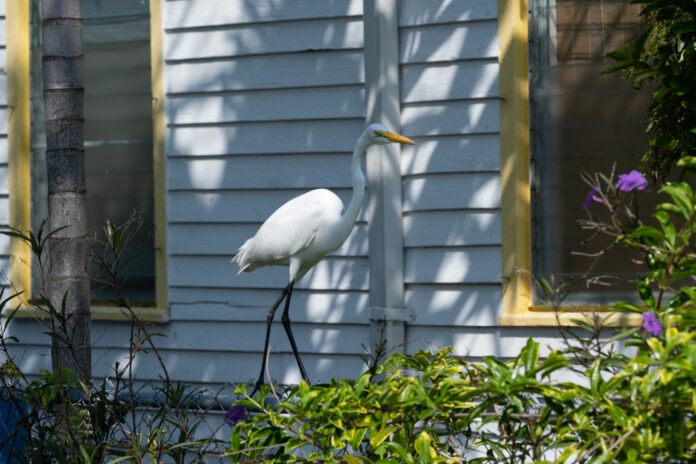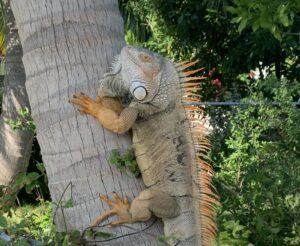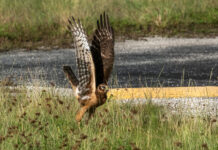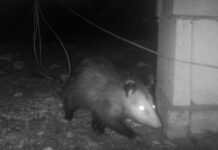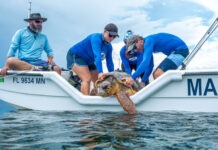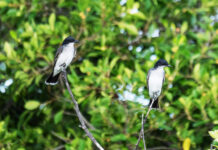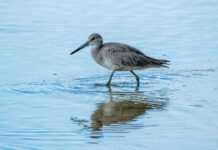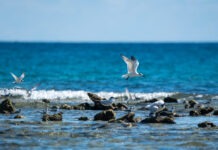It had been a long, crazy week, and I spent most of Sunday on the couch. For a while I watched men ride bicycles up Alpine passes, which was so exhausting I needed a nap. Then I switched to watching men trying to kick soccer balls into nets, which was also exhausting and required further napping. At some point I did actually get up and wash some dishes, if only so I had something tangible to check off the to-do list.
Monday, after doing a bunch of chores that didn’t require me to leave the house, I remembered there was an outside world. I put my binoculars into my bike basket and set out on a slow ride around the island. I rode out on White Street Pier, but saw nary a tern or frigatebird. So I headed east, out toward Smathers Beach.
There’s a section along the Atlantic Boulevard bike path called the Key West Nature Preserve on the map, though I’ve never heard anyone actually call it that. It is largely made up of impenetrable mangroves, some buttonwoods and a few shallow salt ponds. It used to be a solid wall of green when you passed, but since Hurricane Irma the foliage has been more sparse. While passing I saw a trio of white birds.
There’s a phenomenon called “persistence of vision” that has long been used to describe and explain how our brains mash together all the still images in a movie into a perceived vision of motion. It has been similarly applied to how, when someone waves a flaming thing in the dark, like a sparkler, we see a trail of light. It’s based on the theory that our retinas retain images for a fifteenth to a tenth of a second and merge them into a lifelike flow.
There’s a similar effect when you ride by a fence with gaps between the boards, or, say, a bunch of trees or mangroves. The foreground gets blurred as you move, but you can see the things behind the fence/trees/mangroves much more clearly than if you were stopped.
The persistence of vision theory has been disputed by quite a few scientists, though, and the Oxford Dictionary of Film Studies refers to it as “discredited.”
I spent a couple hours reading through academic and research journals trying to figure out what, exactly, is the proper name and explanation for the phenomenon. Retinal persistence? Anorthoscopic perception? Amodal completion?
Honestly, I still don’t know. But the phenomenon exists. It’s how I saw the trio of white wading birds through the trees and mangroves.
They were too distant to identify naked-eyed. It was tempting to attempt to look through my binoculars while riding my bike to try and make use of the phenomenon formerly known as the persistence of vision, but I figured that might end in a serious head injury, or worse, a pair of smashed binoculars. So I stopped at a place where the buttonwoods seemed thinnest.
I couldn’t get a clear view, but by moving my head around, I could pick up different bits of information — they were all tall, all white, and all had black legs. Magnified, I could see a few long, lacy nuptial feathers trailing off the back of one of them. Great egrets, I thought. Feh.
And then I caught myself. I love the novelty of the new and the rare as much as anyone, but commonness shouldn’t be a liability. I made a couple notes on my phone about this using voice to text, which is worth mentioning, if only because when I said “great egrets,” my phone transcribed it as “Grady grits.”
There are a lot of things to like about great egrets, the most obvious being they are beautiful, statuesque birds. On the mainland, outside of extreme South Florida, the great egret is the tallest white wading bird you will see. In the Keys and the Everglades they can be overshadowed (literally) by the great white heron, though with a little experience they are pretty easy to tell apart in most situations.
I like the way that, while they spend most of their time in littoral or riparian habitats, nabbing fish and crustaceans, they also occasionally hunt for food on dry land. I’ve seen them in the middle of farm fields, in the Key West Cemetery, peering through the window of the old Finnegan’s Wake, and walking along the top of my neighbor’s chain link fence, to name a few places.
I like the way that, when they are stalking something, when they are getting close to striking, they will start weaving their head side to side a little, back and forth, giving them a sharper depth of field, the movements so fluid that it almost seems as if the head is floating disembodied, the neck a loose filament tying it to the body. I’ve seen them nab anoles more than a few times.
I like the way when they are ready to attract a mate, they grow these long feathers called aigrettes that drape from their back like a frothy, snowy waterfall.
I knew that great egrets could be found across most of the U.S., and it didn’t surprise me to know they bred all the way south through Brazil, Chile and Argentina. The fact that they can also be found in parts of Europe and most of Africa caught me by surprise. The fact that they can be found in most of Asia, a lot of Russia, and Australia made me think, great egret, I hardly know ye.
I ended up riding my cruiser out to Cow Key Channel, but turned around just after the bridge over Riviera Canal, largely because I’d heard several times over the weekend that things were all backed up at the triangle.
There was a nice tailwind on the way back, and I’d kind of forgotten about the egrets until I passed the Key West Nature Preserve again and saw a dozen or so of them where there had only been three before. I didn’t stop this time, though, just enjoyed seeing them via the persistence of vision. Or whatever you’re supposed to call it.












